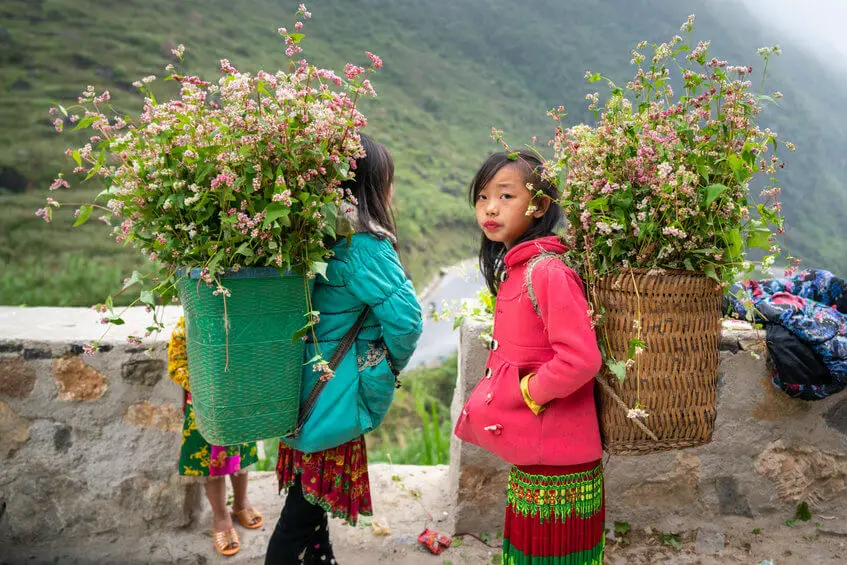On a vacation, I traveled to Sa Pa, a small mountain town where many Ethnic minorities live, with my family. When first arrived, we stopped at the center of the town for sightseeing.
Knowing we are tourists, an Ethnic girl slowly approached us to sell her products. She didn’t say anything but was just handing out bunches of colorful handmade keychains and bags. My mother pitied her so she picked one red keychain and gave it to me.
“Money, please!” the girl suddenly said out loud in fluent Vietnamese. Was that the only sentence she could say? I thought in confusion because just a minute ago she didn’t say a word.
In Sa Pa, I got used to this typical scene of small children running around to sell goods to tourists. However, it was the first time I realized an odd aspect: these kids only learned phrases in Vietnamese (the major language) that help them earn money. This sign of child labor shocked me as it has been deep-rooted into the tradition of poor families.
CURRENT PROBLEMS
Definition of child labor: the use of children in industry or business, especially when illegal or considered inhumane.
According to the US Bureau of International Labor Affairs, around 1.75 million children are estimated to be engaged in child labor in Vietnam. Their age ranges from around 5 to 17 years old, and they have a higher risk of early school drop-out and exposure to physical and mental hardship.
More alarming, a 2018 survey found that 84 percent of children in child labor in Vietnam are concentrated in rural areas. The poorer the region, the worse child labor issues. Furthermore, these youngsters usually work in informal household enterprises which are mostly out of control and supervision from the government, giving rise to illegal child abuse and other intolerances.
In recent years, the world has experienced growth of nearly 9 million children taking part in child labor – which makes them vulnerable to COVID-19, as stated by the International Labour Organization (ILO) and UNICEF. The pandemic has pushed dozens of families to extreme poverty, has forced schools to close, and turned many kids into orphans. The cruel reality has curbed global efforts to eradicate child labor by many countries, including Vietnam.
POSSIBLE SOLUTIONS FOR VIETNAM
Children are the world’s most valuable resource and its best hope for the future
John F. Kennedy
At the present. the top priority of all nations is to prevent COVID-19 from spreading and giving safe vaccines for children throughout the world, so schools can reopen and students can continue education. We need to provide children with the most secure environment to study and develop themselves as education is extremely crucial to fight poverty and child labor matters.
If COVID-19 had successfully been eliminated, further policies regarding child labor in mountainous areas should be implemented in Vietnam. For instance, local governments can provide subsidies to farmers in these regions to stabilize their economy, helping more households earn incomes and escape poverty.
With regard to educational resolution, it is better for parents and adults of Ethnic minorities to be educated about the tremendous consequences of child labor because they are the primary causes for the prevalence of this infringement. By doing so, Ethnic children will have better chance in aquiring fundamental knowledge, ensuring brighter future for the next generation. To have more insight of this approach, you can read further in this article.

A Vietnamese teacher helps her students. Image by Nhan Dan Newspaper
At Project Sprouts, we realize that we can not solve all the problems in a situation like this. But we can seek to make a difference in the lives of needy children by giving them school supplies and encouraging them to continue their education; we can give them winter coats, boots, and blankets to help them stay warm during the cold winter months.
Project Sprouts would love to have you be a part of our community and help us to help worthy children in North Vietnam.
You can find out more about Project Sprouts by clicking here or go to our give now page to donate by clicking here. As we are a grassroots organization, all funds go to help those in need.
Related Content:
How Can Education Help Fight Poverty?
The United Nations’ 4th Sustainable Development Goal – Quality Education has emphasized the importance of education in combating not only poverty but also other societal issues.
Learning how education can support impoverished people will help you understand why the world needs education and what the mission of Project Sprouts is
You can read more by reading How Can Education Help Fight Poverty? by clicking here
How School Closures Affect Students?
In 2018, there are about 260 million children who cannot go to school, this accounts for nearly one-fifth of the global population. That was 2 years before COVID-19 emerged. Now, the situation is dramatically different: it continues to exacerbate after new waves of COVID-19 have delayed schools’ opening. Many more students are out of school; meanwhile, some stopped learning because they lack digital devices to study online.
So, What is really happening?
You can learn more by reading How School Closures Affect Students?. by clicking here

